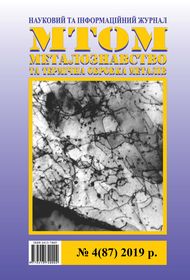Research on the reasons for premature destruction of boiler pipes when operating in a boiler
DOI:
https://doi.org/10.30838/J.PMHTM.2413.241219.57.602Keywords:
low alloy steel, boiler tubes, chemical analysis, microstructure, structural degradation, mechanical propertiesAbstract
Purpose is to establish the reasons for the premature failure of low alloy steel boiler tubes operating in a waste heat boiler in the ammonia synthesis workshop. Methodologies. The work performed: chemical analysis of low-alloy pipe steel on a spectrometer "SPECTROMAX" company "SPECTRO", Germany; visual inspection and study of the surfaces of boiler pipes using a scanning electron microscope REM 106 I; metallographic studies of the structure of steel along the cross section of completely destroyed and non-destroyed pipes; tensile testing of pipe mechanical properties. Results. Based on comprehensive studies, an unsatisfactory initial structure of boiler pipes was established, characterized by pearlitic banding of score 4 and fine grain No. 7−8, as well as a significant change in the structure of steel during operation of pipes in a waste heat boiler in an oxidizing furnace gas environment at elevated temperature and pressure. Based on comprehensive studies, a significant change in the structure and properties of low-alloy pipe steel was established during the operation of boiler pipes in a waste heat boiler in the environment of furnace gases at elevated temperature and pressure. Scientific novelty. It is scientifically substantiated that the cause of the destruction of boiler pipes is the degradation of the structure of low alloy steel, which consists in its decarburization and internal oxidation as a result of physicochemical processes occurring in an oxidizing medium at high temperature and pressure. It is scientifically substantiated that the cause of the destruction of boiler pipes is the degradation of the structure of low alloy steel as a result of physicochemical processes occurring in the environment of furnace gases at high temperature and pressure. Practical relevance. An accident associated with the explosion of a waste heat boiler with unfavorable environmental consequences and possible human casualties was prevented at the chemical industry enterprise. Recommendations are given on improving the operational reliability and durability of boiler pipes without capital expenditures.References
Dergach T.O. Teoretichnі ta tekhnologіchnі osnovi keruvannya strukturoyu dlya pіdvishchennya korozіynoї trivkostі trub z nizkolegovanikh і visokolegovanikh staley [Theoretical and technological bases of structure control for increasing corrosion durability of pipes of low alloy and high alloy steels]. Abstract of the dissertation for the degree of Doctor of Technical Sciences, 2018, 36 p. (in Ukrainian).
Dergach T.A. Issledovaniye prichin razrusheniya trub iz korrozionnostoykoy stali v kipyatilnike proizvodstva ammiaka na PAO «Dneprazot» [Investigation of the causes of corrosion-resistant steel pipe breakdown in a boiler of ammonia production at PJSC Dneprasot]. Metaloznavstvo ta termіchna obrobka metalіv [Metal Science and Heat Treatment of Metals]. Dnipro, 2014, no. 2, pp. 29–33. (in Ukrainian).
Boyko E.A. Kotelnyye ustanovki i parogeneratory [Boiler installations and steam generators]. Krasnoyarsk : KSTU, 2005, 292 p. . (in Russian).
GOST R 55442-2013. Truby dlya kotelnogo i teploobmennogo oborudovaniya. Tekhnicheskiye usloviya [Pipes for boiler and heat exchange equipment. Specifications]. Moscow, 2013. (in Russian).
Oprishko L.V. Structure and service properties of hot-extruded boiler tubes produced from continuously cast billets. Theory and Practice of Metallurgy. 2010, no. 5–6, pp.124–126.
Oprishko L.V., Golovniak T.V. and Vetlianskaya A.D. High-temperature strength of hot-extruded boiler tubes produced from continuously cast billets. Metallurgical and Mining Industry. 2011, no. 5, pp.49–51.
GOST 5640. Steel. Metallograficheskiy metod otsenki mikrostruktury listov i lenty [Metallographic method for assessing the microstructure of sheets and ribbons]. Moscow, 1988. (in Russian).
Bolshakov V.І., Dergach T.O. and Sukhomlin G.D. Sposіb polіpshennya strukturi і vlastivostey trub z nizkolegovanikh staley [A method of improving the structure and properties of pipes of low-alloy steels]. Metaloznavstvo ta termіchna obrobka metalіv. [Metal Science and Heat Treatment of Metals]. 2019, no. 1, pp. 29–33. (in Ukrainian).
Patent No. 88711, Ukraine, IPC C21D 9/08 (2006/01). Sposіb termіchnoї obrobki trub naftovogo sortamentu z nizkolegovanikh staley [Method for the thermal treatment of low-alloy steels oil pipes]. Bolshakov V.I., Dergach T.O. and Sukhomlyn H.D. No. u 2013 13046; claimed 11/11/2013; publ. 25.03. 2014, Bul. no. 6. (in Ukrainian).
Patent No. 2256705 (RU) IPC 7 C21D1 / 25, C21D1 / 56. Sposob termіcheskoy obrabotki izdeliy [Method of heat treatment of products]. Nedospasov L.A., Anointed A.A., Lezhnin K.V., Puiko A.V., Nemtsev S.A., Ryazantsev Yu.M., Schavleva L.A., Deineko L.N., Velichko A.G., Bolshakov V.I. No. 2004102271/02 of 2004.01.26; publ. 07/20/2005. (in Ukrainian).
Rios P.R. and Zöllner D. Grain growth – unresolved issues. Materials Science and Technology. 2018, vol. 34, iss. 6, pp. 629–638.
Published
Issue
Section
License
Authors that are published in this journal agree to follow the conditions:
Authors reserve the right to the authorship of his work and cede the right to the journal of first publication of this work on conditions of the license under the Creative Commons Attribution License, which allows others to distribute it freely with the obligatory reference to the author of the original work and the first publication of the work in this journal.

